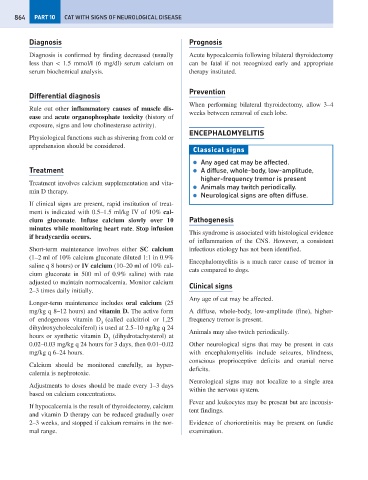Page 872 - Problem-Based Feline Medicine
P. 872
864 PART 10 CAT WITH SIGNS OF NEUROLOGICAL DISEASE
Diagnosis Prognosis
Diagnosis is confirmed by finding decreased (usually Acute hypocalcemia following bilateral thyroidectomy
less than < 1.5 mmol/l (6 mg/dl) serum calcium on can be fatal if not recognized early and appropriate
serum biochemical analysis. therapy instituted.
Prevention
Differential diagnosis
When performing bilateral thyroidectomy, allow 3–4
Rule out other inflammatory causes of muscle dis-
weeks between removal of each lobe.
ease and acute organophosphate toxicity (history of
exposure, signs and low cholinesterase activity).
ENCEPHALOMYELITIS
Physiological functions such as shivering from cold or
apprehension should be considered.
Classical signs
● Any aged cat may be affected.
Treatment ● A diffuse, whole-body, low-amplitude,
higher-frequency tremor is present
Treatment involves calcium supplementation and vita-
● Animals may twitch periodically.
min D therapy.
● Neurological signs are often diffuse.
If clinical signs are present, rapid institution of treat-
ment is indicated with 0.5–1.5 ml/kg IV of 10% cal-
cium gluconate. Infuse calcium slowly over 10 Pathogenesis
minutes while monitoring heart rate. Stop infusion
This syndrome is associated with histological evidence
if bradycardia occurs.
of inflammation of the CNS. However, a consistent
Short-term maintenance involves either SC calcium infectious etiology has not been identified.
(1–2 ml of 10% calcium gluconate diluted 1:1 in 0.9%
Encephalomyelitis is a much rarer cause of tremor in
saline q 8 hours) or IV calcium (10–20 ml of 10% cal-
cats compared to dogs.
cium gluconate in 500 ml of 0.9% saline) with rate
adjusted to maintain normocalcemia. Monitor calcium Clinical signs
2–3 times daily initially.
Any age of cat may be affected.
Longer-term maintenance includes oral calcium (25
mg/kg q 8–12 hours) and vitamin D. The active form A diffuse, whole-body, low-amplitude (fine), higher-
of endogenous vitamin D (called calcitriol or 1,25 frequency tremor is present.
3
dihydroxycholecalciferol) is used at 2.5–10 ng/kg q 24
Animals may also twitch periodically.
hours or synthetic vitamin D (dihydrotachysterol) at
3
0.02–0.03 mg/kg q 24 hours for 3 days, then 0.01–0.02 Other neurological signs that may be present in cats
mg/kg q 6–24 hours. with encephalomyelitis include seizures, blindness,
conscious proprioceptive deficits and cranial nerve
Calcium should be monitored carefully, as hyper-
deficits.
calemia is nephrotoxic.
Neurological signs may not localize to a single area
Adjustments to doses should be made every 1–3 days
within the nervous system.
based on calcium concentrations.
Fever and leukocytes may be present but are inconsis-
If hypocalcemia is the result of thyroidectomy, calcium
tent findings.
and vitamin D therapy can be reduced gradually over
2–3 weeks, and stopped if calcium remains in the nor- Evidence of chorioretinitis may be present on fundic
mal range. examination.

